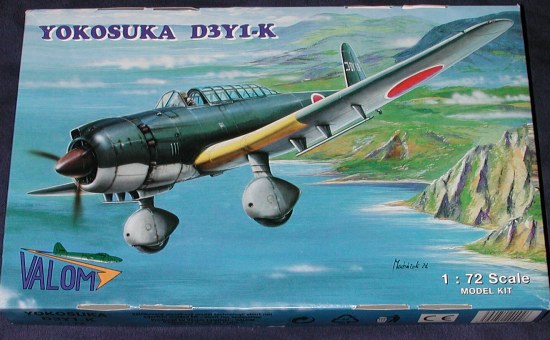
|
KIT: |
Valom 1/72 D3Y1-K |
|
KIT # |
72002 |
|
PRICE: |
£ |
|
DECALS: |
One option |
|
REVIEWER: |
|
|
NOTES: |
Short run with vacuformed canopies, resin, and etched metal fret |

|
HISTORY |
By the end of that year, the Yokosuka D3Y1-K training dive bomber had been developed based on the Aichi D3Y2 'Val'. The goal was to maximize the use of wood on this plane and in the process, the nice elliptical shape of the flying surfaces was gone, replaced by straighter versions. The fuselage was also lengthened in the process.
The first two prototypes were
delivered in mid 1944 and given the name 'Myojo' (Venus). Flight testing
showed a very high weight and a lightening process was undergone prior to
full production. Production of the aircraft was entrusted to the small
Matsushita Company, which produced only three aircraft prior to the end
of the war.
|
THE KIT |

This is Valom's second kit and from the looks of it, an improvement over their first effort. The kit itself comes in a ziplock bag (a great idea, by the way), and consists of a full sprue and separate lower wing. Surface detail is excellent and there is no flash, ejector pin marks or sink areas in any places of consequence. Resin is used for the engine, spinner and cowling. The engine is a separate block and cylinders. While I'd prefer to have a more simpler construct for the engine, this one has holes in the block for the cylinders, unlike the MPM engines on the Wellington I built which just had flat mating surfaces. The etched fret contains the instrument panel, rudder pedals, seat belts, dive brake attachment points, and a myriad of small pushrods for the engine. Two nicely done and thick vac canopies are provided. I like thicker vac canopies as it makes them much easier to work with.
There are no optional parts, which is hardly surprising considering the very low production of the aircraft. Cockpit is adequate for the scale with a floor, two seats and control stick plus the etched bits. The only positive locator for the floor is a groove on the left fuselage half. There are central bulkheads, but no fore or aft one. Typical with the genre, mating surfaces are butt fits.
Instructions are very much like the previous kit with exploded construction views and an excellent color reference chart giving Humbrol, Model Master, Agma, and FS information as well as generic names. The part and color 'balloons' in the construction sequence are quite large. Decals are for one aircraft as shown on the box art in dark black/green upper, light grey lowers and yellow wing ID stripes. Decals are thin and in register.
|
CONCLUSIONS |
Personally, I'm quite pleased that aircraft of this type
are being kitted. Valom has some very interesting models planned and I'm
looking forward to them. I'm also looking forward to building this one to
see for myself how much improvement has been made. Thanks to VALOM for the review sample. Squadron Mail Order
carries these kits in the US. If you would like your product reviewed fairly and quickly by a
site that has over 200,000 visitors a month, please contact
me or see other details in the Note to
Contributors.